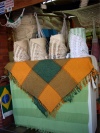
 |
Weavings
The Jequitinhonha River valley in the mountainous state of Minas Gerais is famous not only for its pottery, but also for some very beautiful textiles. The most common fiber is cotton, and the designs are usually flowers, dolls, houses, and churches. They can be merely decorative, or utilitarian: bedspreads and pillow covers, table runners, and placemats. In the interior of Rio Grande do Sul there are a lot of weavers, knitters, etc. also. That's where we took the photos of the placemats, the crochet table runner, and the scarves below. The fabulous neckwarmers and scarves in the last photograph are made in São Borja, Rio Grande do Sul, near the Argentinian border. The gorgeous red curtains are available from a store in São Paulo that works with artisans around the country, helping them with more sophisticated designs to better use their skills and increase their income.
 |
 |
 |
 |
 |
 |
 |
Arraiolo Rugs
The city of Diamantina (the name comes, as you might have guessed, from the Portuguese word for diamond) is located in the Jequitinhonha River Valley in the state of Minas Gerais. It is well-known all over Brazil for its beautiful, high-quality rugs done in a traditional Portuguese needlework, arraiolo, that was adopted by local artisans a long time ago. The designs are embroidered in wool yarns onto a rami net and finished with a short fringe in natural color loops.
The Diamantina arraiolos have a certificate of authenticity sewn on the reverse side and are sold at authorized dealers in all major cities in Brazil. There are area rugs - round or rectangular, runners for hallways, and small hearth rugs. Next time you're in Brazil, why not treat yourself to one of these beauties?
Rag Dolls
Rag dolls are very popular at markets in Northeastern Brazil, especially Pernambuco. They come in all sizes, from "mother dolls" with breasts to mid-size families holding hands and bride-and-groom duos to tiny little things that have hundreds of use, the limit is your imagination: they decorate pillows, curtains, throw them in bowls to give away as party favors, etc. In Rio, as part of an effort to give employment to very poor women at Favela da Maré, they sell these adorable groups of kids dancing in a circle.
Fuxico
Fuxico is a lovely way to work with pieces of fabric that might get thrown away otherwise. The name comes from the verb "fuxicar" or gossip, which is what you do when you sit around a table to do this (sort of the Brazilian version of a quilting bee). Here is a marvelous fuxico pillow from Ouro Preto, Minas Gerais, that is embroidered with tiny beads on top of the fuxico work. Fuxico can decorate kitchen towels, tablecloths, or curtains; in Rio you will find colorful necklaces made with fuxico and beads.
Hammocks
Brazilian hammocks are very large and elaborately woven, embroidered or hand-crocheted, with wide decorative fringes in filé lacework or crochet. Some are done in plain cotton, but most are very colorful. There is a great variety of designs, but the most well-known and popular come from the states of Ceará and Maranhão in northeastern Brazil.
 |
 |
Hammocks have been in use since colonial times, when European settlers adopted them from the native population. They are a common sight in Brazilian homes, where they are hung in verandas, balconies, and living-rooms. If you've never let yourself cuddle inside a Brazilian hammock, you don't know what you're missing! When my daughter was a little girl, I bought a couple of miniature hammocks for her dolls. You'll find them in markets in northeastern Brazil (as the one hanging from the ceiling on this photo). They're awfully cute things!